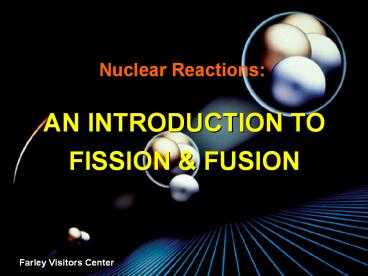Nuclear Reactions: AN INTRODUCTION TO FISSION & FUSION - PowerPoint PPT Presentation
1 / 19
Title:
Nuclear Reactions: AN INTRODUCTION TO FISSION & FUSION
Description:
Nuclear Reactions: AN INTRODUCTION TO FISSION & FUSION Farley Visitors Center Nuclear reactions deal with interactions between the nuclei of atoms The focus of this ... – PowerPoint PPT presentation
Number of Views:651
Avg rating:3.0/5.0
Title: Nuclear Reactions: AN INTRODUCTION TO FISSION & FUSION
1
Nuclear Reactions
AN INTRODUCTION TO FISSION FUSION
Farley Visitors Center
2
Introduction
- Nuclear reactions deal with interactions between
the nuclei of atoms - The focus of this presentation are the processes
of nuclear fission and nuclear fusion - Both fission and fusion processes deal with
matter and energy
3
Matter and Energy
- Previous studies have taught us that matter and
energy cannot be created nor destroyed - We now need to understand that Matter and Energy
are two forms of the same thing
4
E mc2
- Matter can be changed into Energy
- Einsteins formula above tells us how the change
occurs - In the equation above
- E Energy
- m Mass
- c Speed of Light (Universal Constant)
Mass
Energy
Light Speed
5
E mc2
- The equation may be read as follows
- Energy (E) is equal to Mass (m) multiplied by
the Speed of Light (c) squared - This tells us that a small amount of mass can be
converted into a very large amount of energy
because the speed of light (c) is an extremely
large number
6
Fission
- Fission may be defined as the process of
splitting an atomic nucleus into fission
fragments - The fission fragments are generally in the form
of smaller atomic nuclei and neutrons - Large amounts of energy are produced by the
fission process
7
Fission
- Fissile nuclei are generally heavy atoms with
large numbers of nucleons - The nuclei of such heavy atoms are struck by
neutrons initiating the fission process - Fission occurs due to electrostatic repulsion
created by large numbers of protons within the
nuclei of heavy atoms
8
Fission
- A classic example of a fission reaction is that
of U-235 - U-235 1 Neutron
- 2 Neutrons Kr-92 Ba-142 Energy
- In this example, a stray neutron strikes an atom
of U-235. It absorbs the neutron and becomes an
unstable atom of U-236. It then undergoes
fission. Notice that more neutrons are released
in the reaction. These neutrons can strike other
U-235 atoms to initiate their fission.
9
Fission
- The fission process is an a natural one as a
French researcher found a natural uranium reactor
in Gabon, West Africa it has been estimated to
be over 2 billion years old - Fission produces large amounts of heat energy and
it is this heat that is captured by nuclear power
plants to produce electricity
10
Fusion
- Fusion is a nuclear reaction whereby two light
atomic nuclei fuse or combine to form a single
larger, heavier nucleus - The fusion process generates tremendous amounts
of energy refer back to Einsteins equation - For fusion to occur, a large amount of energy is
needed to overcome the electrical charges of the
nuclei and fuse them together
11
Fusion
- Fusion reactions do not occur naturally on our
planet but are the principal type of reaction
found in stars - The large masses, densities, and high
temperatures of stars provide the initial
energies needed to fuel fusion reactions - The sun fuses hydrogen atoms to produce helium,
subatomic particles, and vast amounts of energy
12
Review
- Mass and Energy are two forms of the same thing
neither can be created nor destroyed but mass can
be converted into energy (E mc2) - Fission is a nuclear reaction in which a heavy
atomic nucleus is split into lighter atomic
nuclei - Fusion is a nuclear reaction in which 2 light
atomic nuclei are combined into a single, heavier
atomic nucleus
13
Quiz
- Which nuclear process produces large amounts of
energy? - A. Fission
- B. Fusion
- C. Both fission fusion
- D. Neither fission nor fusion
14
Quiz
- Fission is the process that _________ atomic
nuclei. - A. Combines
- B. Burns up
- C. Stores
- D. Splits
15
Quiz
- Mass may be converted into energy.
- A. True
- B. False
16
Quiz
- The fission process requires heavy atomic
nuclei. - A. True
- B. False
17
Quiz
- Name a nuclear reaction that occurs within the
sun
18
Quiz
- Fission is a natural process that occurs on the
planet Earth. - A. True
- B. False
19
Quiz
- Explain this equation
- E mc2































